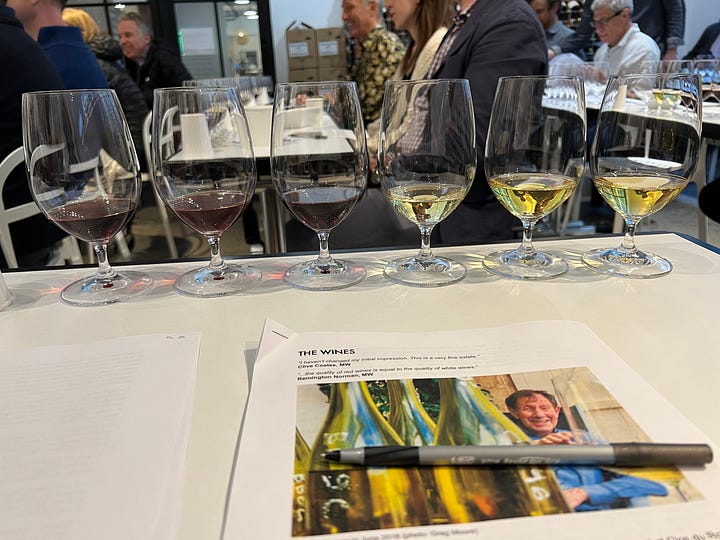Trust Fall: The Media’s Elusive Pursuit of Mass Appeal
Is there a middle ground solid enough to support 'unbiased' news business models? Plus: The New Museum's Summer Program and Brand Newsroom's latest culinary adventures
Editor’s Note: This post is deemed too long for email, so you’ll have to click the link to read it in its entirety. It’s worth it! — DK
“Trust and Media in a Post-Truth World” might sound a tad histrionic. Nevertheless, it served well as the title of a panel discussion examining the public’s fraught relationship to the news media. The summit was hosted last month by 1440, the Chicago-based curated newsletter operation that bills itself as “the best unbiased news source” — a bold claim.

1440’s co-founder/Editor-in-Chief Drew Steigerwald got a chance to defend the six-year-old company’s premise in a conversation with such big names (at least to people who read Substacks about the media) as New York Times media reporter Katie Roberson, Slate Editor-in-Chief Hillary Frey, and Executive Editor of The News Movement Jessica Coen (formerly of Morning Brew, Mashable, and Vanity Fair).
The moderator of 1440’s inaugural Gutenberg Summit was Brian Stelter. If you’re reading this, you don’t need to be told Stelter was a lightning rod for right wing media in his former perch as the host of CNN’s Reliable Sources weekly show. Interestingly enough, the 1440 panel event was held a week after Chris Licht, who was alleged to have dismissed Stelter as part of a purge intended to tame CNN’s perceived combative stance toward Republicans, was himself forced out following a damning profile in the Atlantic Monthly.
Back to that title. There was, indeed, a sense of urgency regarding the state of disrepute suffered of late by mass market journalism. But there was something else: a genuine attempt to get to the bottom of what, if anything, can unite a polarized populace that appears intractably committed to self-selected, impermeable media bubbles.
Panelists responded to the challenge of parsing “Trust and Media in a Post-Truth World” by wrestling with definitions of “bias” and “disinformation” while discussing their readership, how to build loyalty, and finding the right business model when coverage driven by partisan definitions of “fairness and balance” appear to be the real revenue drivers.
The speakers didn’t duck the tough questions. Their difficulty with the topic was inspiring, even if the answers weren’t completely satisfying.
Those who care about the epistemic crisis of American life have been sounding the alarms about the fate of journalism in the face of mis-, dis-, and flat-out false information and none of us have any direct solutions. So it was a something of a relief to see these professionals contend with the issues, and at least succeed in holding up a mirror to the audience of journalists bent on the same mission.
Yes, some were old school, some were established. But some, like 1440, were bright-eyed optimists set on fixing the trust issue once and for all. What did they come away with?
Trumped Up Crises
If you can trust Gallup and the James L. Knight Foundation, you will agree with the summit panel: we have a real information crisis. And it’s growing worse.
According to a recent Gallup/ Knight Foundation report, trust in the news media has fallen to its lowest point in five years, with 53% of Americans expressing an unfavorable view. At the heart of it, Americans feel lied to and manipulated; about 50% of Americans suspect national news organizations “intentionally mislead, misinform, or persuade the public.”
It's not surprising given the five years we’ve just slogged through: Trump, the pandemic, Trump, climate controversies, Trump, immigration crisis, Trump, the Jan 6th insurrection.
We are a nation under pressure. As a result, we are increasingly divided, engaged in a cold civil war involving memes, mudslinging, mockery, along with cycles of outrage. How predictable then trust in the media should feel so lost.
Swiftboating, Gaslighting, Fake News, Alternative Facts, Both Sidesism
Did mistrust begin to fester with Fox News’ ratings rise built on rage? The Swiftboating of poor John Kerry? With Kelly Anne Conway’s alternative facts? With those sordid tales of sex trafficking from Washington, D.C. pizza parlors? Did fossil fuel corporations’ obfuscation about climate concerns make fear-mongering profitable? Did politicians use the pandemic “lockdowns'' to gather zealots?
No matter the answers to those questions, the main goal of news organizations now is to acknowledge the ravages of PTTD (Post-Traumatic Trump Disorder) and work to rebuild trust.
Maybe we can even go deeper. Maybe we can recognize that the enormous, necessary changes to the foundations of American life over the last 50 years would naturally lead to realignment and dislocations. The steady, if woefully incomplete, entry of Black people, LGBTQi+, and yes, even women, into positions that demand respect was always going to have a massive backlash.
Simultaneous to those overdue social corrections was the attenuated, not totally inaccurate angst that middle class upward mobility was a diminishing prospect in America.
Ball that up into the moment we are in now and you have a combustible schism that views truth through a lens of defending hard won, justifiable gains against a sense of bitter grievance the looks back to traditional hierarchies to make things right.
Although 1440’s summit made it abundantly clear that no one knows how to go about traversing the widening breach, maybe just “talking it out” can help reach a proximate solution to an insoluble problem.
Where to start? For the 1440 panelists, it begins with shifting the perspective media outlets speak to audiences that have chosen separate corners of the public square.
The Business of Unbiased News
“Unbiased news” is having a major moment. 1440 is only one of many newbies in the journalism field promising that their platform maximizes news and minimizes persuasion. A quick Google search landed a few of the latest and most earnest contenders, each with taglines (one even trademarked!) promising to eradicate partiality from our newsfeeds:
The News Movement Don't be fooled by media bias & misinformation.
Straight Arrow Unbiased. Straight Facts. (TM)
“All Sides Don't be fooled by media bias & misinformation.
The Factual Unbiased News, Trending Topics
1440 All of your news. None of the bias.
And yet, at the summit, “bias” as a defining issue was swiftly left in the bin. Slate’s Frey called it “subjectivity” while even 1440s’ Steigerwald conceded that “being ‘unbiased’ is not a goal unto itself.”
“What you're trying to do,” he explained, “is make a product for your readership. And they want something you can call ‘clean information.’”
But what is “clean information?”
Who knows? “Free of agenda” was proposed. In any case, bias is either inherent or very bad, or both. But rather than avoiding the idea altogether, there was some acknowledgement that transparency about where a publication is coming from is necessary.
Different bottom lines, Objectively Speaking
Whatever your take on 1440’s brand identity, Steigerwald’s point about making “a product for your readership” was honest. Even if he seemed to pivot away from strictest view of 1440’s own tagline, there was a somewhat humble admission: what any news outlet really needs to do is match the qualities of its news reporting to the needs and expectations of the audience. Well, that seemed downright actionable. Sort of the bedrock of any business model. Um, kind of like, the ones we already see in use, no?
Oh well and anyhoo, the bottom line remains the bottom line. Still, news is considered a public service, not just another consumable product. Maybe treating it chiefly as an entertainment product meant to keep viewers watching and clicking 24/7 is a major source of eroded trust in journalism?
Hmmm… Still, the news business is a business after all.
So the issue becomes defining that bottom line. In the case of the old guard — from the Grey Lady to Slate — the necessary balance isn’t so much about readers’ political expectations, but balancing what they need to know with what they want to know and offering clear, recognizable editorial judgment as the glue to win readers that advertisers value.
Context and Truth
Frey made it a point to emphasize repeatedly that Slate had an audience that does not necessarily want “objectivity” (commonly derided as “the view from nowhere”) — at least not in the sense that the newer media properties were after.
They want the analysis that their credible Slate journalists (like Dahlia Lithwick who covers the courts for Slate) provide to make the stories comprehensible. They want context and, yes, objective (in this case, “verifiable, not dogmatic”) truth.
As the famous Pat Moynihan quote goes, we are entitled to our own opinions, not our own facts. Still, facts are always up for debate and interpretation. It’s just a matter of news readers not wanting to be spoon-fed. They want proof that news reporting and analysis are backed up by proof. As Frey noted, there is no blank slate tabula rasa news consumer who just wants “the facts” as handed down from an unquestionable authority from on high.
“The context that we provide is the truth,” she said.
In this atmosphere of distrust, any news media company — entrenched, fully established, or newbie —needs to demonstrate that its output is not deliberately misleading, nor even seeking to unduly influence its audience. More than ever, the news needs to sell its honesty.
1440, with its promise of unbiased news, is selling a different sort of honesty to a different sort of reader. That reader, Steigerwald, indicated, was not a “newsie.” Neither are they a card-carrying extreme left- or right-wing zealot. That reader was part of what he called “the broad middle” and who media wonks refer to as “news adjacent.”
Courting the Middle and The ‘News Adjacent’
Indeed, that seems to be the reader many of the new unbiased companies are courting. That —largely imagined if you ask me— wide-eyed innocent, quivering in fear or anger of being overly influenced or lied to, and looking for a hero to curate and filter “the news.”
One has to ask, though, if courting the “news adjacent” is as easy as just stating (or curating) the facts.
Here’s Steigerwald attempting to demonstrate what the straight news about Donald Trump’s recent indictment would look like to this broad middle reader:
“Here's a description of what's in the indictment,” Steigerwald said. “And then you sort of do the work. Like, ‘Here's a link to the indictment, here's the background, everything.’ And you stop there.
“If you keep going, you get into ‘[Republican House Majority Leader Kevin] McCarthy said this’ and then ‘A [Democratic opponent] said that.’ All that back and forth ultimately turns away readers of all stripes. In the end, the reaction after reading something like that is, "Who gives a shit —sorry —what Kevin McCarthy is saying?”
But Steigerwald did have to add context: it turns out this “broad middle” reader “self-identifies as right” and is offended by journalists who seem to be chasing facts that depict the right as wack-a-doo.
There’s always a contextual issue: how, and by whom, was a story chosen (let alone featured?), what context is relevant and what isn’t and to whom? Which experts do we choose to weigh in?
As Brian Stelter put it, “The word ‘disinformation’ meant something a few years ago. Then it got weaponized. Now disinformation is whatever you don't want [to hear or read], right?”
When I did my quickie Google research on “unbiased news,” I found that the issue of trust was, not only not engendered by news outlets with that promise of unvarnished reporting, but sometimes exacerbated my own negative perceptions by attempts to simply “play it straight.”
I had no trust at all, for instance, in the choice of politically and culturally unaligned outlets featuring Hunter Biden’s latest woes as the day’s most urgent headline. There’s no arguing its not news, but is its positioning more about stoking an emotional reaction rather than illuminating potential corruption?
I had no trust in the wan displays of transparency that included placing left-leaning and right-leaning pundits side by side without mud wrestling visually in my restless mind — without a referee in sight —to direct me toward the relevance. Consequently, whether I got served a bland newsletter, or a platter of both-sidesism, it was bound to arrive with a side of frustration.
Facts are facts; simply offering and appealing to “all points of view“ feels patronizing, rather than respecting the reader’s intelligence to separate context from conjecture.
The New News: Curate and Filter
Lastly, let’s move on from false nostalgia about the “good old days.” If we’re talking about trust in the media, the big dip seems to have started rather recently.
A Pew poll two years ago found that between 2016 and June of 2021, the portion of all adults that said they had “a lot” or at least “some” trust in the information that comes from national news organizations fell from 76 to 58 percent.
Anyway, we know it feels like the Cronkite era was the last moment of “ media credibility. At the very least, one could, with peace of mind, purchase a big ol’ paper and get on a train or sit in a café and, ensconced in its inky wisdom, read quietly. One could then walk away, rolled up broadsheet or tabloid in hand, feeling informed.
Something like that is kinda true.
Sometime in the murky past, this changed, and people started, quite wisely, and with increasing frequency —and then matching ferocity —evaluating the sources of that news, the influences, the biases. This was healthy. This was intelligent.
The established news outlets could deal with it. They had their brand of storytelling and their readership. They were trusted enough — enough, that is, to maintain their bottom line. (Yes, they also didn’t find themselves competing in endless 24/7 news cycles, but let’s not make excuses. The media business was never easy money, as Citizen Kane once noted.)
Then, gradually, somehow, after many unmasked lies and conspiracies and whistle blowers and political tampering and hedging, well, it seems we entered this “post-truth” age.
Something like that is the consensus.
Notably this consensus is mostly about politics, and when it is about other things, such as science, it is still about politics.
We don’t — any of us — trust the politics of others. Not our peers, our neighbors, our judges, our institutions —and certainly not our journalists.
Still trusted, just enough to maybe stay afloat, established news companies and magazines are struggling with the new “post-truth” mentality by doubling down on their assets: pundits, experts, beloved essayists. Some of them have begun to introduce “balance” (a nod toward acknowledging polemics) with a bit of he-said/she-said.
Many have introduced disclaimers like “stated without evidence” to alert the poor embattled news consumer that someone is lying their ass off.
But for some, this is not enough. There’s this whopping gap, this “broad middle,” this hoard of harried truth seekers yearning to be free of opinions and agendas.
For those news consumers, we have this new wave of unbiased news outlets.
From what I’ve seen, these depend largely, not on researching and building stories, but upon curation of the established news sources they were meant to serve as a correction for.
The new news doesn’t necessarily put boots on the ground — no Maggie Habermans here— nor does it provide an in-house roster of talking heads and experts — no Dahlia Lithwicks— instead it ushers in guest speakers and hands the megaphone to “both sides” of hotly debated topics.
The curatorial approach has its complications. Take a look, please, at All Sides, and then journal your feelings. Do these “from the left, from the right, from the center” designations create a sense of control or simply add to your anxiety?
I found myself worrying that such designations could re-bias news items for people who already think in these terms. What about the “All Sides” bias-meter? Do you trust it to be … unbiased?
It’s daunting, this noble experiment. However, I’m going to sum it up this way: we do have a trust crisis and we do have differing degrees of distrust. We do have a need for a media business model that caters to the growing number of news consumers who shun traditional media sources. And we do have 1440 and All Sides, Straight Arrow, and The Factual on the cutting edge, earnestly (I assume) seeking solutions. Already I’ve seen citations of All Sides’ bias-meter.
And we do have summits with panels that take measure, trade ideas, and hold up that crucial mirror. If anything, it shows that rather than raging from a Media Mount Olympus, the old and new journalism voices on the stage are at least fighting for the truth, wherever it may be.
Art Dept: ‘I Literally Wept’
The New Museum of Contemporary Art on the Bowery is challenging. That’s what I like about it. I like visiting a museum that has, as its sole agenda, introducing truly new, category-defiant works to the visiting public. If art matters, then the New Museum is more relevant than ever because of their mission to present and amplify groundbreaking creativity.
So it was with great pleasure that I attended the New Museum’s preview of its summer program with four floors of focused, intense, urgent, installations by four passionate artists.
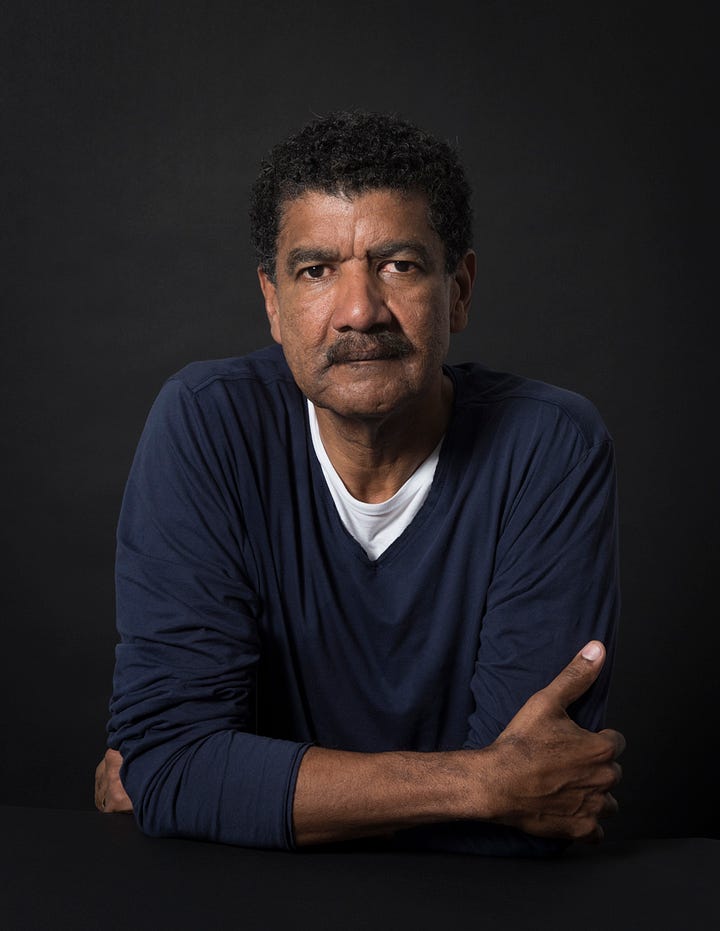

.” A group of large-scale multi-media installations so resonant that I wept — literally wept — while standing before one of them. Badge of Honor (1995) clobbers the viewer with the real-life impact of mass incarceration. One must stand far back to take it all in at once: on the left, a prison cell, on the right, a fantastical depiction of a teenage boy’s bedroom with all his dreams and aspirations depicted via multimedia collage.
On the walls of their respective cell and bedroom, the talking heads of an incarcerated father and his teenage son carry on a conversation. It had to be the best, most moving installation I’ve ever witnessed.
The summer program includes the first U.S. solo shows of three other artists: Mire Lee, Wynnie Mynerva and Tuan Andrew Nguyen. Collectively, the program indicates an interesting new mood in the creative zeitgeist, one that embraces and celebrates emotion.
I’m talking feelings —not lofty philosophies regarding process and image-making, nor debates about the relevance of one medium or another — but flat-out honest weeping, shrieking, struggling, and sharing.
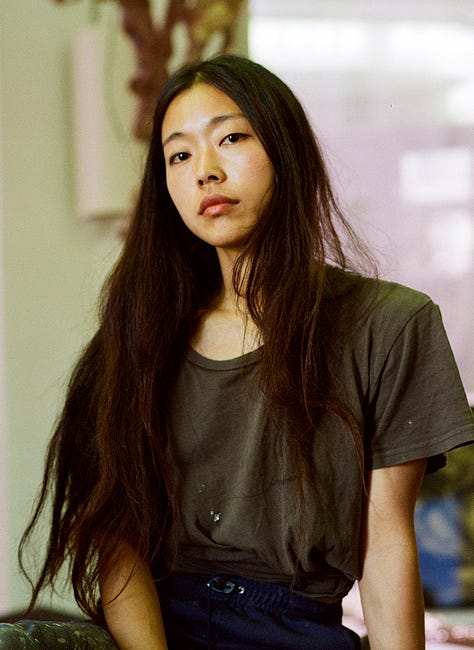
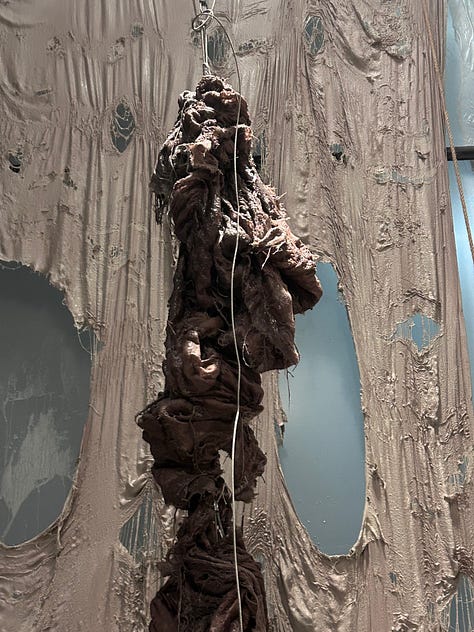
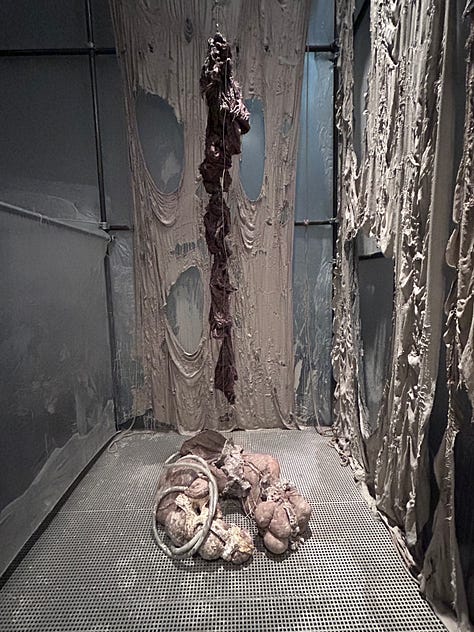
Mire Lee brings some very real darkness to the museum’s fourth floor. She’s created a murky, mud addled, plastic enclosed space literally dripping with water, oil, silicon, and clay slip, hung from the ceiling, colossal sculptures weep and sag. They appear like a series of interconnected mechanisms; churning and gathering, their large bodies leak and drip and accumulate clay deposits which will slowly harden and “kill” the machinery.
Speaking of killing the machinery, Wynnie Mynerva’s ground floor installation consists of a mural and a reliquary sculpture displaying one of the artist’s own rib. It’s a contemporary re-fabling of the old Adam and Eve story with the apocryphal story of Lilith, Adam’s first partner, grafted into it.
A large mural scrolls through a colorful, painterly, epic in which Mynerva has Eve meeting Lilith, which leads to the two of them killing Adam as the murderous duo goes on to live on, free of gender enslavement.
Mynerva had their own “Adam’s rib” removed and incorporated into an accompanying sculpture. The display, with all the gravity of a saintly relic, amplifies the mural’s sense of bodily integrity gained through struggle and sacrifice.

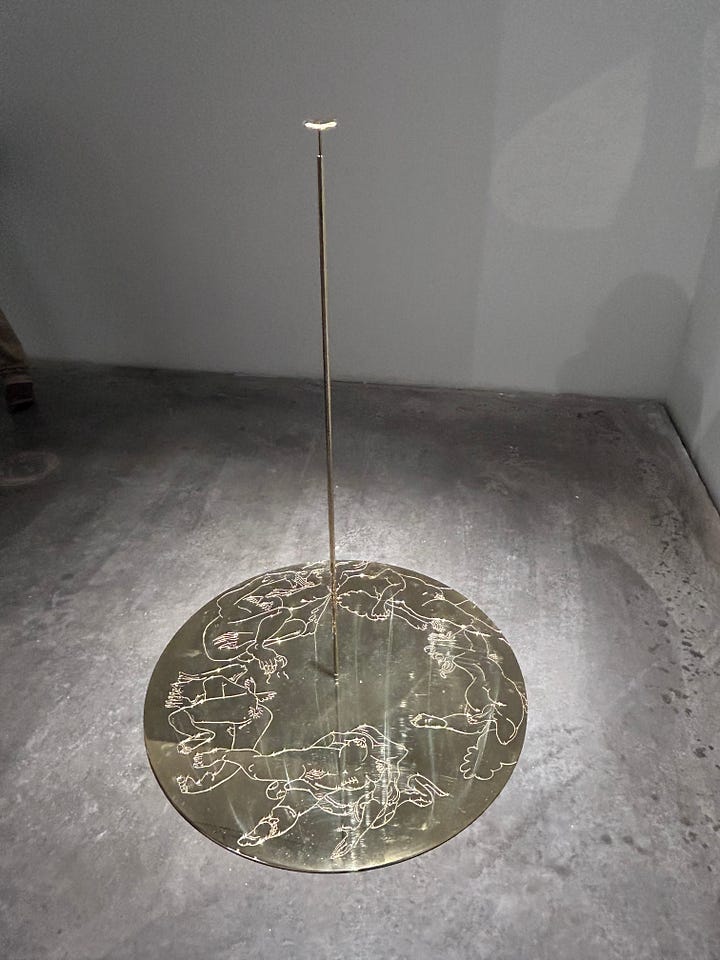
Ho Chi Minh City artist, Tuan Andrew Nguyen, similarly re-tells stories with film, video and archival materials that use factual, mythological, and remembered histories of resilience through cultural identity and defiance in the face of war and colonialism.
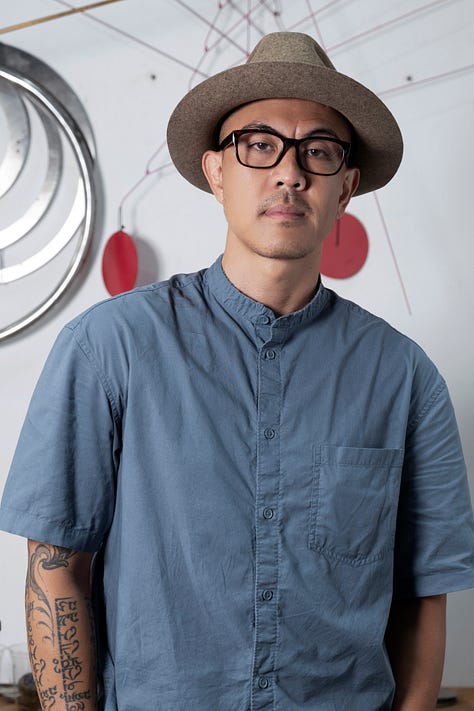
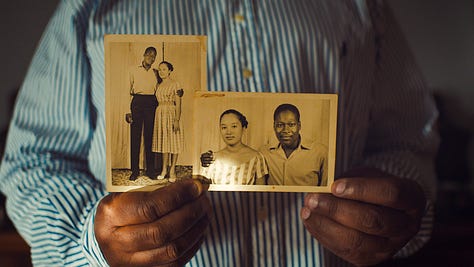

Visitors will be rewarded by repeated visits to the museum’s third floor to take in all of “Tuan Andrew Nguyen: Radiant Remembrance,” which gathers a new full length film, two video projects, small and large-scale mobiles made from artillery shells and bomb metal, photos and archival material; together these express, not only the interwoven experiences of peoples from Vietnam, Senegal, Morocco, France and the United States, but a larger picture of the power of stories.
What We’re Imbibing
We here at Brand Newsroom are fond of our wine fridge and our buddies at Moore Brothers Wine Company help us keep it stocked with the finest small vineyard bottles. We order often, visit bi-monthly, and learn a lot while chatting with Echo and Bill, as well as the owners, Greg and Terry Moore. We are also quite fond of the store’s lovingly curated tasting notes which have provided us with a wine tasting vocabulary worthy of any oenophile’s envy.
I, Cat, am not so much a snob as David, willing as I am to ingurgitate the flabbiest rosés when out and about on a given summer’s eve. But I do enjoy a fine Burgundy as much as David does.
So you can imagine our thrill when Greg Moore invited us this past Monday, to a tutored tasting of six fully mature white and red Burgundies! Straight from the cellar of Domain Robert Ampeau et Fils, the tasting involved sipping three white and three red Premiers Crus while Gregg told us all about the Burgundy wine regions and the history of the Ampeau family and vineyard.

Gregg was sorry about his randomly sized maps, apologizing while we happily wrapped ourselves around Ampeau’s Auxey-Duresses les Ecusseaux, a 1990 dream come true.

